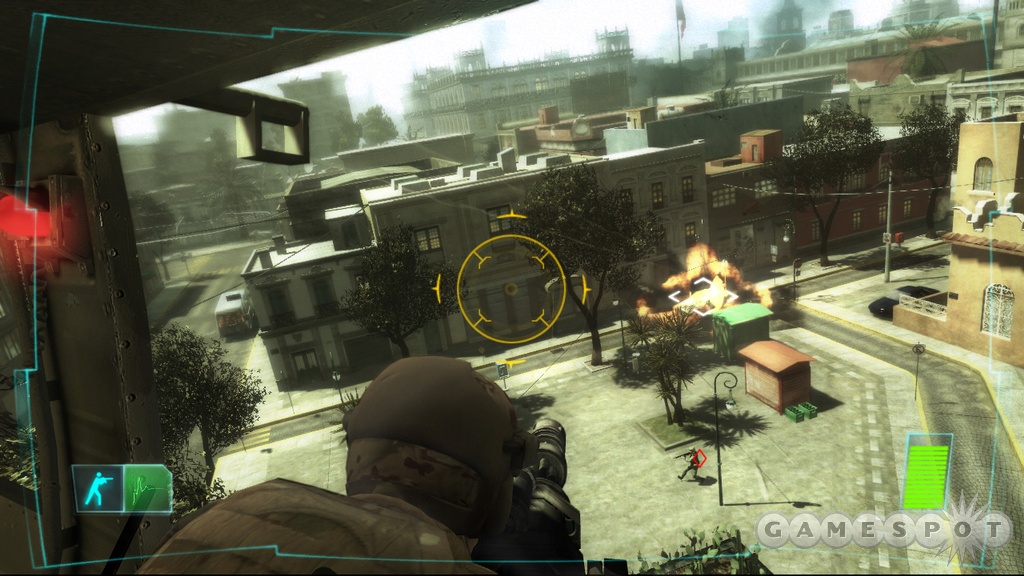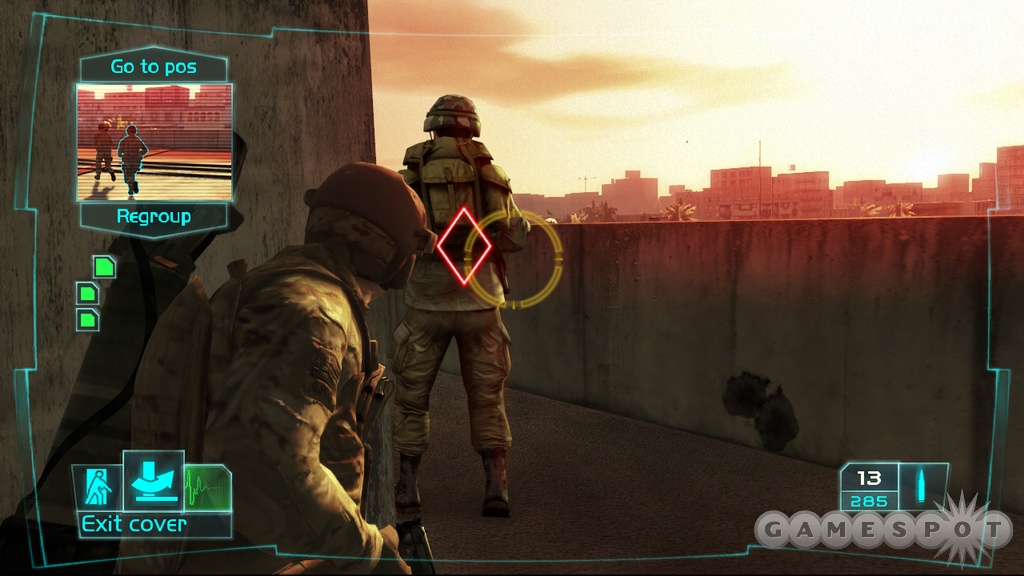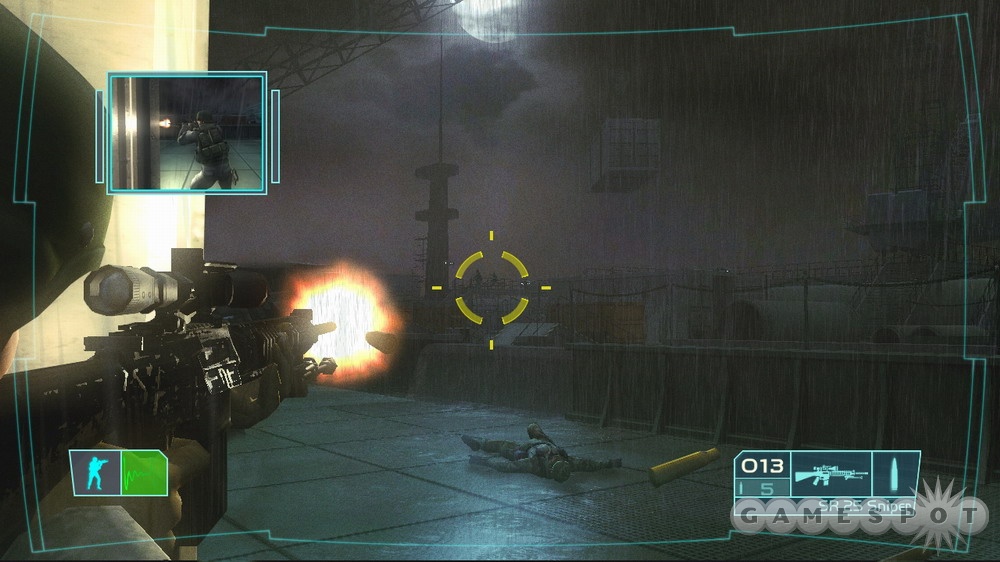Ghost Recon Advanced Warfighter Designer Diary #1 - Audio
Red Storm's Jeff Wesevich discusses the challenges of creating sound effects and music for Ubisoft's upcoming tactical shooter.
Now less than a week away from hitting stores, at least for the Xbox and Xbox 360, Tom Clancy's Ghost Recon Advanced Warfighter is a near-future tactical shooter set in Mexico City. If you've been following our previous coverage of the game, you already have a reasonably good idea of how the game will look and play. But how will it sound? If the amount of work and attention to detail that audio lead Jeff Wesevich has put in is any indication, it won't fail to impress.
Sounding Natural
By Jeff Wesevich
Audio Lead, Red Storm Entertainment
If the audio folks have done their job well, the end result should be something that sounds natural and effortless. Since it doesn't sound like we've been working hard (wait--that's not right...), I thought I'd take this chance to show you some of the behind-the-scenes effort that has gone into the game.
Probably the most noticeable change in GRAW Online's audio is the addition of music to the action phase. The decision to add music took quite a bit of thought, if for no other reason than one of the Ghost Recon's most singular sound design features has been that it relied solely on sound effects once the action started.
The assignment we gave sound designer Fran Dyer and composer Jim Crew was not easy. We did want the additional emotional impact and heightened suspense from the underscoring, but did not want to wallpaper the missions with music, or obscure any of the action or the ambience. When you're trying to track someone's footsteps, the last thing you need to hear is the string section from the Prague Symphony.
With all that said, we've been really pleased with the results. The music is definitely in there and working, but it seems to emanate from the scene and situation, instead of being layered on top of the other effects. The lift is there, but its abstract enough not to force any particular emotion on the player. And since it plays only in response to certain situations, we can play it sparingly enough so that it can create more of an impact.

Ghost Recon's environments have always been a series strong point, but sound designer Justin Drust's treatments on the online levels is as detailed and complex as anything I have heard. In some areas (underneath the piers in "Wharf," the scrap yard in "Nowhere," the urban setting of "Treasury"), I believe we're getting very, very close to what you would expect to hear in a feature film, which is quite an accomplishment given that we have to do everything in real time. While we still have a ways to go before the whole package sounds like Gladiator, the detail we've been able to get into this iteration of the series (wind causing sounds to trigger, sounds muffled when passing underneath bridges, our rain effects, and the like) shows that we may be able to achieve this in the not-too-distant future.
We've also added quite a few effects tricks to the bag, such as using spatialized multichannel sounds. In the past, we've had to drop down to mono for most things we wanted to position in space. So while we had nice stereo samples for the player shooting, we had to use mono for everyone else. Now, we can use the same crisp, clear material across the board, which is one reason why it's so easy to differentiate between weapons and pick out where they're coming from if you're using surround. Sounds better, helps you play better.
Outdoor environments present real challenges for both renderers and sound engines. By taking advantage of the Xbox 360's CPUs, we've been able to make big strides toward having our effects sound much more natural. We're now able to do a much better job of tracing the sound's path through the level geometry so that it arrives at the player's ears as it would in the real world. One of the biggest changes here is the addition of obstruction filtering, which is a fancy term for modeling how objects like fences or buildings or boulders partially block sound. In addition to helping to create better-sounding environments, these changes also help supply the subconscious clues that we use every day to determine the location of sounds, which in turn gives the player a better picture of what is happening (and where) in the game.
GameSpot: Can you describe the new 3D sound system?
Jeff Wesevich: Being an "outdoor" game presents a unique set of challenges for dynamic, fully 3D environments. Unlike in a dungeon crawl, where sound travels in a reasonably linear path from room to room, GRAW Online's soundscapes are made up of effects that often might have traveled several hundred meters, through all kinds of terrain, before reaching the listener.

The audio engine we're using was written specifically for the Xbox 360 console, and with it we're able to do a much better job of tracing the sound's path through our level geometry. One of the biggest changes here is the addition of obstruction filtering, which is a fancy term for modeling how objects like fences or buildings or boulders partially block sound. In addition to helping to create better-sounding environments, these changes also help supply the subconscious clues that we use every day to determine the location of sounds, which in turn gives the player a better picture of what is happening (and where) in the game.
Apart from just tracing, the sounds themselves have been enhanced, as we've switched over to multichannel effects for almost everything we want to spatialize. In the past, we've had to drop down to mono for most things we wanted to position in space. So while we had nice, phat stereo samples for the player shooting, we had to use mono for everyone else. Now, we can use the same crisp, clear material across the board, which is one reason why it's so easy to differentiate between weapons and pick out where they're coming from if you're using surround. Sounds better, helps you play better.
GS: Why is this only possible "next-gen"?
JW: We've had some of these features before now, but they've either cost so much CPU or took so much data that we could use them only as special effects. The 360's horsepower and XMA hardware data decompression have enabled us to use them just about whenever/wherever we think they sound best.
GS: How does sound impact gameplay?
JW: In addition to helping make the environments come alive, GRAW Online uses its audio to present a broad spectrum of information, even apart from messages from your commander and teammates. For openers, sound tells you that someone's shooting at you, and how close they're getting. We have a very complex system that manages bullets whizzing past and/or hitting the ground around you--it's a big part of what makes GRAW feel dangerous.
Aside from the shooting and finding the bad guys, sound contributes in a number of subtle ways, from hearing unseen enemies speak (when I hear "Si, sargento," I know something bad is about to happen) to the low "oof" my character makes when I accidentally slam him into a wall. It is solid, after all! Finally, the emotional lift you get from the music adds a touch that we've never had before in the series.
GS: How did you get sounds like the gunshots, that give the game its realistic edge?

JW: The base weapon-effects set was recorded and processed by Danetracks in Los Angeles. The other effects appearing in GRAW originate from a variety of sources: Ubisoft's huge libraries, our own recording, and others. I use the term "originate" because anything that appears in the game has either been sound designed from scratch or heavily edited so that their in-game effect is similar to their real-world equivalents.
GS: Graphics seem to be the focus when people talk about next-gen titles. What can we look for from "next-gen" audio?
JW: I think you're already beginning to hear a lot of the things that the 360 is making possible, and of course things are only going to improve as we get even more familiar with the console's capabilities.
In the short-term, I think we'll see more virtual sound positioning so that the sounds of footsteps will actually come from "around the corner," instead of through walls. With this in place, players will be able to truly "follow the shooting" to find the quickest way to the action.
For the longer term, I'm excited about using the 360's CPU to create dynamic mixing solutions. One of the hardest things to get around when you're comparing film sound to game sound is the need for the game to mix everything on the fly. Now all we need is an artificial intelligence routine smart enough to emulate a supervising sound editor...
GS: How important is sound to GRAW's single- and multiplayer?
JW: The best way to answer this question is to turn the volume up on your surround system, get into a firefight, then click the mute button on your receiver. Survey says that you'll notice.
GS: Thanks for your time.
Got a news tip or want to contact us directly? Email news@gamespot.com
Join the conversation